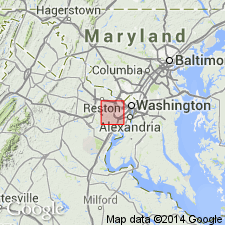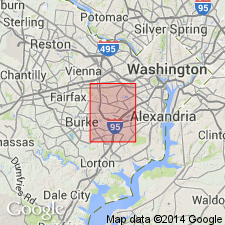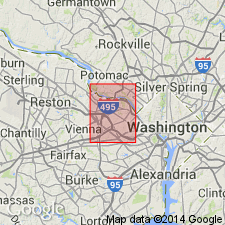
- Usage in publication:
-
- Annandale Group*
- Modifications:
-
- Named
- Dominant lithology:
-
- Schist
- Sandstone
- AAPG geologic province:
-
- Piedmont-Blue Ridge province
Summary:
The Annandale Group, an allochthonous unit here named for Annandale, Fairfax Co., VA, was originally termed the informal Eastern Fairfax sequence by Drake and Lyttle (1981). It contains the Accotink Schist and overlying Lake Barcroft Metasandstone. The Group is thought to be an upward coarsening sequence of an outer submarine fan association. It overlies the Indian Run Formation, with which it forms a melange-allochthon motif, on the Red Fox thrust fault; it underlies the Sykesville Formation melange on the Burke thrust fault. It is intruded by the Occoquan Granite of Cambrian age. Age is probably Late Proterozoic although it must be considered Cambrian or Late Proterozoic.
Source: GNU records (USGS DDS-6; Reston GNULEX).

- Usage in publication:
-
- Annandale Group*
- Modifications:
-
- Age modified
- AAPG geologic province:
-
- Piedmont-Blue Ridge province
Summary:
The age of the Annandale Group, including the Accotink Schist and Lake Barcroft Metasandstone, is now believed to be Late Proterozoic and (or) Early Cambrian because the Annandale Group has had a much more complicated geologic history than the younger Popes Head Formation, which unconformably overlies it, and the precursory melanges, the Sykesville and Indian Run Formations. All the lithotectonic units in the area are intruded by the Occoquan Granite, which may be as young as Late Cambrian, based on an Rb-Sr age of 494+/-14 Ma.
Source: GNU records (USGS DDS-6; Reston GNULEX).

- Usage in publication:
-
- Annandale Group*
- Modifications:
-
- Overview
- AAPG geologic province:
-
- Piedmont-Blue Ridge province
Summary:
Annandale Group is older than Indian Run Formation because Indian Run contains olistoliths of Annandale Group rocks. Annandale Group underwent major deformation before emplacement of Falls Church Intrusive Suite (revised) (Drake and Froelich, 1986; Drake, 1987). Age is Late Proterozoic and (or) Early Cambrian.
Source: GNU records (USGS DDS-6; Reston GNULEX).
For more information, please contact Nancy Stamm, Geologic Names Committee Secretary.
Asterisk (*) indicates published by U.S. Geological Survey authors.
"No current usage" (†) implies that a name has been abandoned or has fallen into disuse. Former usage and, if known, replacement name given in parentheses ( ).
Slash (/) indicates name conflicts with nomenclatural guidelines (CSN, 1933; ACSN, 1961, 1970; NACSN, 1983, 2005, 2021). May be explained within brackets ([ ]).

